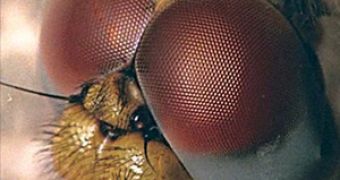For most of us, a fly is a pest but, it turns out, its eyes could revolutionize robot vision (employed for unmanned vehicles, guided missiles, and high-speed industrial inspection robots in medical, commercial, industrial, and defense areas), improving and speeding up the detection of edges and boundaries of objects situated far beyond the capacities of traditional sensors - as is the case with tiny, moving objects.
A team from the Naval Air Warfare Center in China Lake, California, and the University of Wyoming has come up with a fiber optic sensor mimicking the compound eye of the common housefly, Musca domestica. The new technique is detailed in the Bioinspiration & Biomimetics journal.
Flies have a visual precision far beyond the resolution limit (a trait named hyperacuity and common to many species, including humans). "The fly has significant advantages with respect to tracking. As a system, the fly has very quick reaction times? They can react and track much better than untrained humans; however, I would question that the quality of the rest of their vision is even comparable. Overall, insect vision (and sensor technology inspired by it) is still far inferior to human vision, and probably will always be," the researchers told PhysOrg.
In the fly's vision system, the visual field of each photoreceptor overlaps with those next to it, to a percentage that can go up to 90. Each large compound eye has about 3,000 ommatidia (the basic eye unit) and each ommatidium has 8 photoreceptors. Photoreceptors turn light into electric signals transmitted to the fly's visual nervous centers. While conventional image processing systems are in most cases digital, the fly's processing system is analog.
Digital systems operate on data pixel by pixel, and require long and expensive computational processing. The analog system is more rapid and allows parallel processing, explaining the insect's highly accurate, high-speed vision system. The new sensor imitates the fly's overlapping photoreceptors and analog processing system.
The sensor is made of a 1-mm-diameter ball lens, gathering light onto a set of photodetectors, whose visual fields overlap by about 70%. In tests, the sensor could locate with minimal error a 1-mm-wide string moving across the visual field at distances up to 200 mm from the lens. At the moment, the sensor is made of 7 ommatidia with 7 photoreceptors, but the scale and accuracy could be increased.
"We envision this sensor as a supplement to more traditional imaging sensors for most applications, and not as a replacement. Just as Musca domestica has both two compound eyes and a very simple camera eye, many computer and robot vision tasks can benefit from both types of sensors," wrote the authors.

 14 DAY TRIAL //
14 DAY TRIAL //